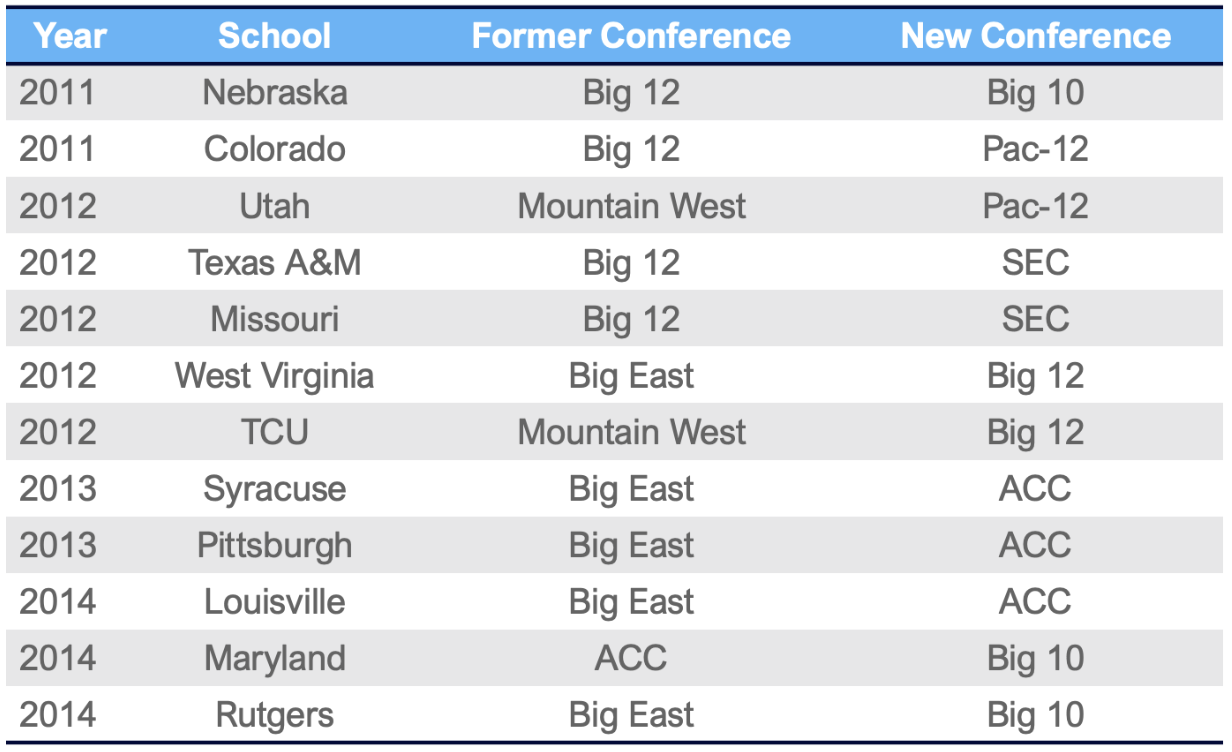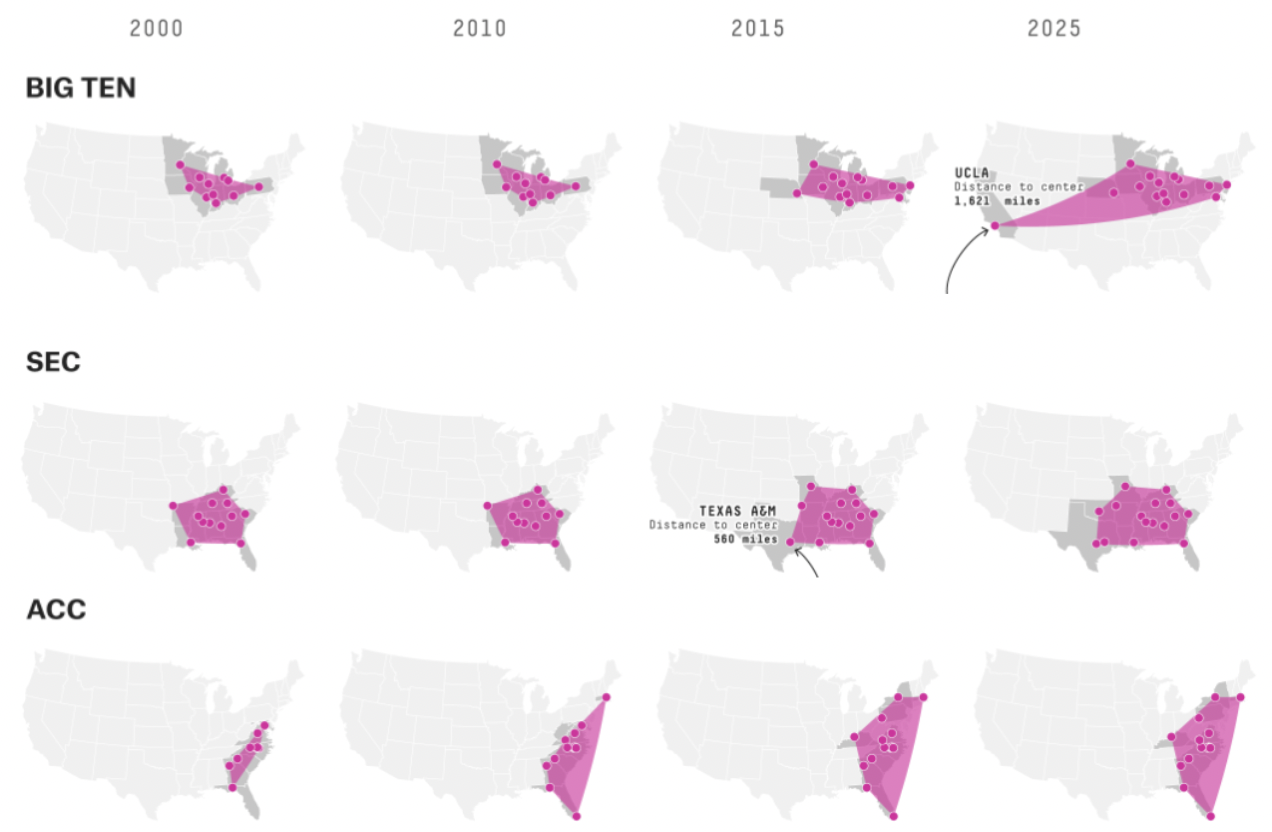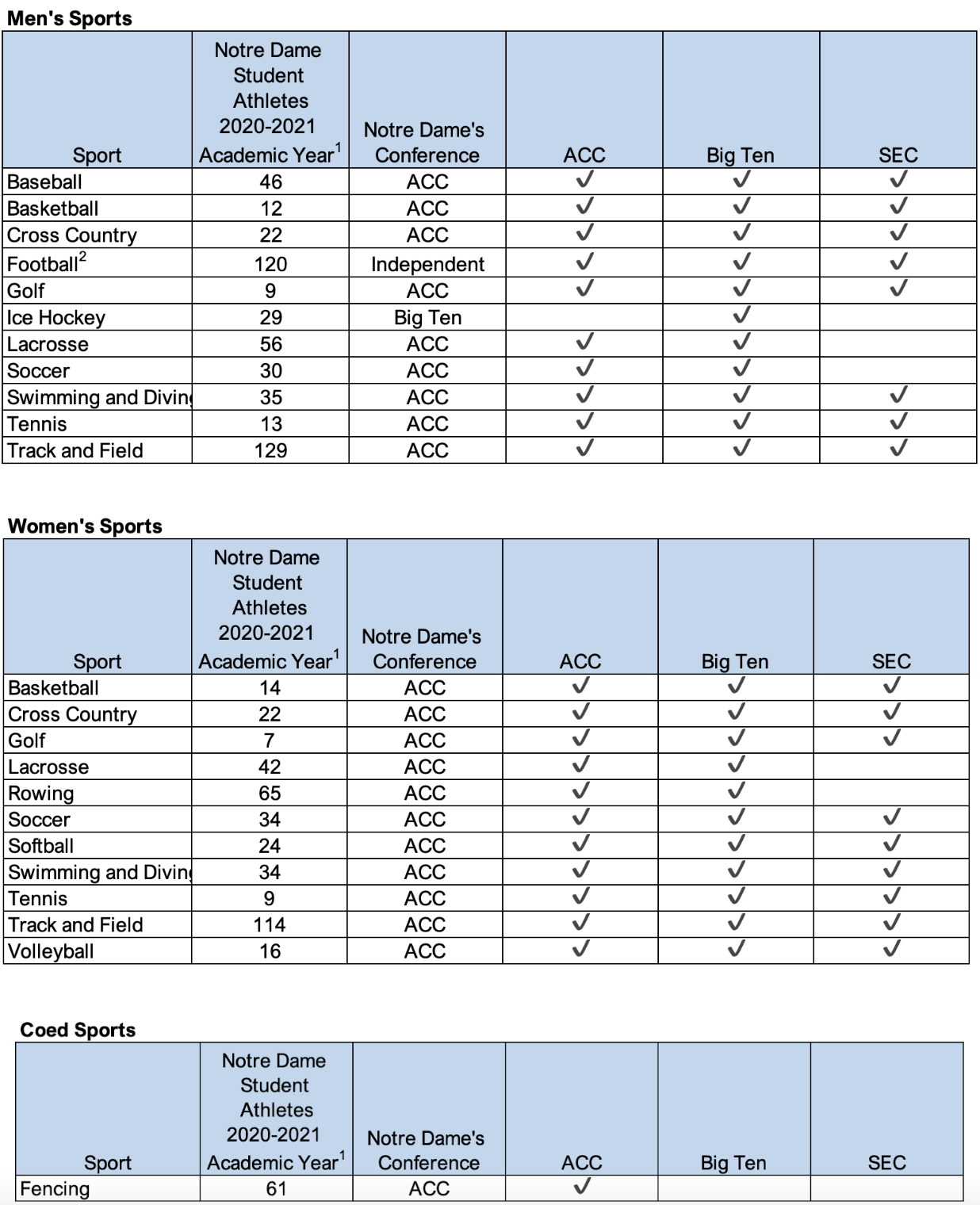An abridged version of this article originally appeared on University Business
The Notre Dame college football team is independent. What would happen if it joined a conference? Let’s look at the data behind a decision like this and the possible economic outcomes.
The landscape of college football is rapidly changing. We saw this play out between 2011 and 2014 when 12 major universities switched conferences (see below). Over the seven years that followed, there were numerous rumors of impending moves but little activity.
In July 2021, Texas and Oklahoma announced their moves from the Big 12 conference to the SEC conference starting in 2025. Then in June 2022, USC and UCLA announced their departures from the Pac-12 conference to the Big Ten conference starting in 2024 (see our previous blog, “USC, UCLA Big Ten Playbook” here). This shift left the ACC, Big 12, and Pac-12 conferences vulnerable to further expansion of the SEC and Big Ten 16-team “super conferences.” This has prompted a new wave of conference realignment talks, and many view Notre Dame as a prime target for any conference looking to add to its ranks.

Why Are Athletics Important to Colleges and Universities?
Athletic departments generate revenue for academic institutions primarily in three forms: 1) ticket sales, 2) alumni/booster donations, and 3) NCAA/conference distribution. Athletic departments also spend considerable amounts on coaches’ salaries and benefits, scholarships, travel, and facilities.
Athletics impact the brand of a university. For example, 75 percent of schools that make it into the Final Four of the NCAA men’s basketball tournament see a larger-than-normal surge in applications received the following admissions cycle, according to data from the National Center for Education Statistics.
Colleges and universities should consider the academic side of their sports teams. Adding or removing a team could substantially impact an institution’s tuition revenue, financial aid, and instructional expenses. It behooves most colleges and universities to analyze the financial contribution of their student athletes by sports teams. Further research could break down the academic programs the student athletes are majoring in. Doing so could project the impact of roster adjustments to sports teams on academic programs in terms of enrollment and economics.
A Tradition in Football Independence
Notre Dame’s roots in football independence date back to 1887, when the Michigan football team taught them how to play the game. The region-focused Big Ten spurned the Irish three times in the early 1900s. Coach Knute Rockne was forced to take his team on the road via railroad to face teams in the midwest and on the west and east coasts. On these barnstorming tours, the small South Bend, Indiana school bested much larger institutions and gained national notoriety. The program has won 13 national championships while maintaining its football independence.
Criteria for Joining a Conference
In August 2022, during a live chat with university vice president Lou Nanni, Notre Dame’s athletic director Jack Swarbrick outlined the criteria a conference would need to fulfill for Notre Dame to consider joining.
- A committed broadcast partner. In 1990, Notre Dame entered a national contract with NBC to broadcast all home games. This contract has been renewed and runs through 2025. Any new broadcast partner would need to compensate the university for its media rights in a way that allows it to be competitive. Under its current deal, NBC pays Notre Dame $15 million annually in media rights revenue. In comparison, the Big Ten recently announced an agreement with Fox, CBS, and NBC that could provide Big Ten conference members an average annual payout of more than $70 million. Sources told CBS Sports that Notre Dame would remain independent if it could earn at least $75 million annually from NBC.
- Access to the College Football Playoff. Under the current four-team playoff format, Notre Dame has made the playoff in two of the last four years as an independent. It was recently announced that the field for the playoff will expand from four teams to 12 teams, starting as early as 2024 and as late as 2026, making the playoff more accessible.
- A good home for Notre Dame’s Olympic sports. Notre Dame must look beyond its football program and factor its other sports into this decision. It’s vital to the university that its teams can compete for national championships in these sports. Scheduling is a crucial component of this. As each conference expands geographically, student-athletes are required to spend additional time on team travel. The graphic below shows the growing footprint of the Big Ten, SEC, and ACC.

Sources: Sports-Reference.com, Simplemaps
Notre Dame’s Options
Considering the recent conference realignment, Jack Swarbrick is evaluating several different alternatives:
- Remain a partial member of the ACC with independence in football
- Become a full member of the ACC, including football
- Move all sports to the Big Ten
- Move all sports to the SEC
Notre Dame’s Affiliation with the Atlantic Coast Conference (ACC)
In 2012, Notre Dame entered the ACC conference as a sponsored member. The football program maintained its independence but is scheduled to play five ACC opponents yearly. The ACC does not offer ice hockey; therefore, the men’s team competes in the Big Ten. Under the ACC grant of rights deal, Notre Dame may not leave the ACC for another conference until 2036. Breaking this deal would require a sizeable exit fee estimated at $120 million. Although the football program recruits nationally, the geographic area covered by the conference has proven to be fertile recruiting ground. The Covid pandemic ended college football seasons for many teams and some conferences during the 2020 season. As an independent, Notre Dame’s season had been threatened. However, the ACC allowed it to be a full member for the season, which was mutually beneficial for Notre Dame and the ACC.
Other Sports
Beyond football, Notre Dame offers 10 other sponsored men’s teams, 11 women’s, and one coed team, listed below.

¹ Source of Notre Dame student athlete data: Gray DI
² Football is under contract to play 5 ACC opponents each year.
Moving All Sports to the Big Ten. The Big Ten offers all of Notre Dame’s current sports except fencing. Fencing is a coed sport predominantly offered by ACC and Ivy League schools. In moving to the Big Ten, Notre Dame could potentially add three sports not currently in the ACC: men’s wrestling, women’s field hockey (see example below), and women’s gymnastics.
Moving All Sports to the SEC. The SEC offers two sports not currently offered in the ACC: women’s equestrian and women’s gymnastics. However, the SEC does not offer many of Notre Dame’s current sports, including coed fencing, men’s ice hockey, men’s and women’s lacrosse, men’s soccer, and women’s rowing.
Academic Program Economics of Sports Teams
As mentioned above, if Notre Dame were to move its other sports teams from the ACC to the Big Ten or SEC, it would gain exposure to new sports not currently sponsored by the ACC. One example is women’s field hockey in the Big Ten. A roster for such a team typically includes over 20 student-athletes. What if Notre Dame were to launch a new women’s field hockey team? In addition to the athletic department costs (e.g., coaches, travel), the university should consider the impact on Education and other academic program areas that field hockey players are likely to major in. The academic economics of field hockey is very favorable, as shown in this disguised example of a team in this sport.

Combining sports economic data with academic program evaluation systems empowers both athletic directors and provosts to analyze the data and foster collaborative decision-making. This leads to better outcomes for both athletics and academic departments. It also allows schools to find new ways to bolster the enrollment of specific academic programs by launching new cost-efficient sports.
Notre Dame’s Next Move
When USC and UCLA announced their move from the Pac-12 to the Big Ten, Notre Dame’s knee-jerk reaction could have been to leave football independence behind and join a conference. However, the university remained patient and stood its ground. It appears poised to continue to do so until external circumstances leave them with no choice but to join a conference. The key factors in this decision will include tradition, media rights revenue, scheduling, travel, and access to the college football playoff. Only time will tell if this day ever comes.
This type of analysis can be applied at other schools considering a conference change or just looking to add new sports based on market demand and program economics. These decisions also affect the enrollment of academic programs as certain sports attract students who major in specific programs. At Gray DI, we are developing a dashboard and datasets to help schools understand the results of these decisions. Click here if you would like to learn more.




